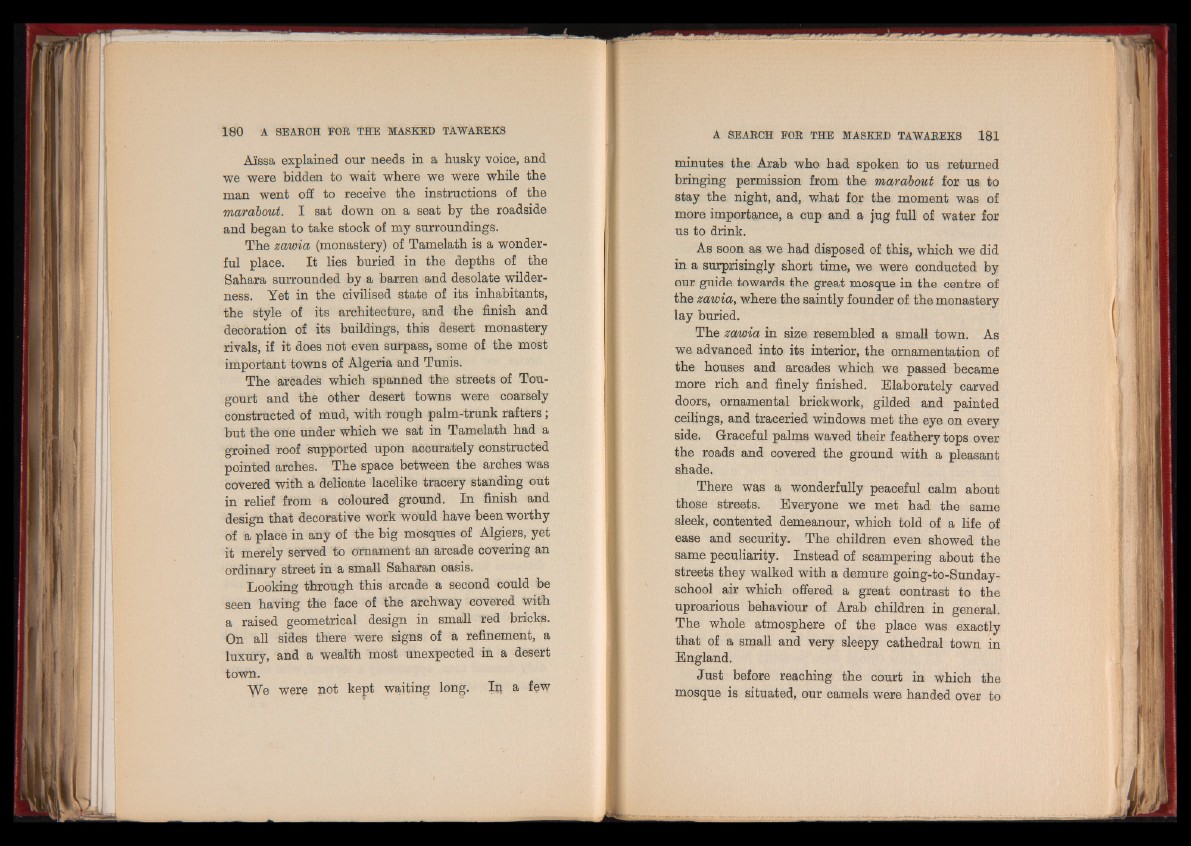
Aissa explained our needs in a husky voice, and
we were bidden to wait where we were while the
mfl.n went off to receive the instructions of the
marabout. I sat down on a seat by the roadside
and began to take stock of my surroundings.
The zawia (monastery) of Tamelath is a wonderful
place. It lies buried in the depths of the
Sahara surrounded by a barren and desolate wilderness.
Yet in the civilised state of its inhabitants,
the style of its architecture, and the finish and
decoration of its buildings, this desert monastery
rivals, if it does not even surpass, some of the most
important towns of Algeria and Tunis.
The arcades which spanned the streets of Tou-
gourt and the other desert towns were coarsely
constructed of mud, with rough palm-trunk rafters;
but the one under which we sat in Tamelath had a
groined roof supported upon accurately constructed
pointed arches. The space between the arches was
covered with a delicate lacelike tracery standing out
in relief from a coloured ground. In finish and
design that decorative work would have been worthy
of a place in any of the big mosques of Algiers, yet
it merely served to ornament an arcade covering an
ordinary street in a small Saharan oasis.
Looking through this arcade a second could be
seen having the face of the archway covered with
a raised geometrical design in small red bricks.
On all sides there were signs of a refinement, a
luxury, and a wealth most unexpected in a desert
town.
■^Ve were not kept waiting long. In a few
minutes the Arab who had spoken to us returned
bringing permission from the marabout for us to
stay the night, and, what for the moment was of
more importance, a cup and a jug full of water for
us to drink.
As soon as we had disposed of this, which we did
in a surprisingly short time, we were conducted by
our guide towards the great mosque in the centre of
the zawia, where the saintly founder of the monastery
lay buried.
The zomia in size resembled a small town. As
we advanced into its interior, the ornamentation of
the houses and arcades which we passed became
more rich and finely finished. Elaborately carved
doors, ornamental brickwork, gilded and painted
ceilings, and traceried windows met the eye on every
side. Graceful palms waved their feathery tops over
the roads and covered the ground with a pleasant
shade.
There was a wonderfully peaceful calm about
those streets. Everyone we met had the same
sleek, contented demeanour, which told of a life of
ease and security. The children even showed the
same peculiarity. Instead of scampering about the
streets they walked with a demure going-to-Sunday-
school air which offered a great contrast to the
uproarious behaviour of Arab children in general.
The whole atmosphere of the place was exactly
that of a small and very sleepy cathedral town in
England.
Just before reaching the court in which the
mosque is situated, our camels were handed over to